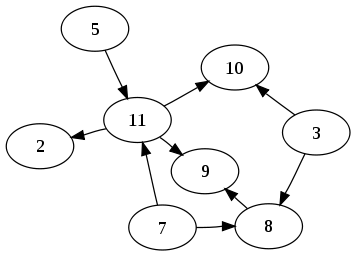Not as a recursive structure, like your binary tree.
You could use a list of nodes, and for each store which nodes it is has an edge to.
( (2 ()) (3 (8 10)) (5 (11)) (7 (8 11)) (8 (9)) (9 ()) (10 ()) (11 (2 9 10)) )You could store a list of nodes and edges.
( (2 3 5 7 8 9 10 11) ( (3 8) (3 10) (5 11) (7 8) (7 11) (8 9) (11 2) (11 9) (11 10) ) )

